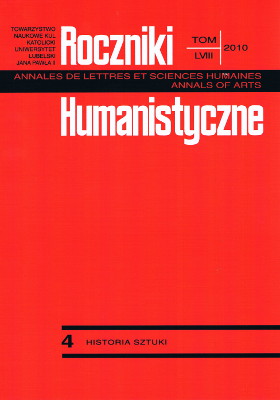“Don’t Turn Back”. An Essay on a Mythological Gesture
Abstract
Throughout history, cultures of diverse peoples often develop similar, virtually identical myths and legends. Although they are created independently in disparate communities, in different times and places, they reveal unbelievable similarities and analogies. This holds good for both fully-fledged stories and for individual elements of the plot, which become universallike symbols in human imagination over generations. This state of affairs testifies to the universal nature of “symbolic thinking,” and to the existence of common archetypical roots of all cultures, storing images of people, things and events that are symbolic in nature.
Gestures are one of the archetypal elements. In the analysed case, gestures are understood as signs of natural expression, dictated by a more or less conscious impulse. These signs are manifestations of somatic and spiritual transforming experiences that a person goes through. They are also a means of communication between the person and the reality s/he experiences. In this sense, they give insight into this person’s reality. One of the most intriguing gestures is that of turning back, looking back on one’s past. It is known first of all from the Orphean myth and the biblical story about Lot’s wife. Nevertheless, it is also to be found in other stories all over the world.
When he was about to leave the underworld – where he attempted to retrieve his wife Eurydice – Orpheus turned back despite the evident ban on doing so. Orpheus’ turning back doomed Eurydice to eternal imprisonment captivity in the world of the dead. Her despaired husband went back alone to the realm of the living. In a similar story, Coyote – a protagonist of a myth popular in a North American Indian tribe – followed his deceased wife to the world of the shadows. He failed to take his beloved back as he succumbed to the temptation of running to her and trying to touch her. Izanagi, a god in the Japanese mythology, ignored the warnings and when he went to the underworld, he took a torch and looked into the face of his deceased sister-wife Izanami. Brothers of a Hawaiian hero Maui also experienced the grave consequences of turning back, when they lost a chance of consolidating all the Hawai islands into an archipelago. A warning against turning back is also included in the Chinese Book of Changes (I Ching). A commentary to its last hexagram warns men against stopping on their way, encourages them to move forward and resist the temptation to stop and look back on the danger they have survived. The Bible also repeats a similar word of warning. The best known instance is the gesture of Lot’s wife, who turned back on her escape from Sodom. She was changed into a salt pillar. Also, the words of Jesus, who warns people against looking back when they start plough work. The last example comes from Tennyson’s story of Lady of Shalott, who turned back from the magical mirror.
References
Bastian D. E., Mitchell J. K., Handbook of Native American mythology, wyd. ABC-CLIO 2004.
Borgen R., Ury M., Readable japanese mythology: selections from Nihon shoki and Kojiki, „The Journal of Association of Teachors of Japanese” 1990, vol. 24, nr 1.
Eliade M., Obrazy i symbole. Szkice o symbolizmie magiczno-religijnym, przeł. M. i P. Rodakowie, Wydawnictwo KR, 1998.
Gayton A. H., The Orpheus Myth in North America „The Journal of American Folklore” 1935, vol. 48, nr 189, s. 263-293.
Grimal P., Hades, [w:] Słownik mitologii greckiej i rzymskiej, Wrocław: Zakład Narodowy Imienia Ossolińskich 19902.
GrosLouis K. R. R., The significance of sir Orfeo's self-exile, „The Review of English Studies”, New Series 1967, vol. 18, nr 71, s. 245-252.
Hultkrantz A., The North American Indian Orpheus Tradition: A Contribution to Comparative Religion, Monograph Series, publ. no. 2, Ethnographical Museum of Sweden, Stockholm 1957.
Kopaliński W., Hades, [w:] Słownik wyrazów obcych i zwrotów obcojęzycznych, Warszawa: Wiedza Powszechna 198917.
Kroeber K., Retelling/rereading: the fate of storytelling in modern times, Rutger University Press 1992.
Krokiewicz A., Studia orfickie. Moralność Homera i etyka Hezjoda, Warszawa: Wydawnictwo Alatheia 2000.
Krolick S. W., Gesture and myth: a phenomenological reflection on myth and traditional culture, „Man and World” 1981, vol. 14, nr 2.
Matthews J. i C., Orfeo, [w:] Mitologia Wysp Brytyjskich, przeł. Z. Ziółkowska, Poznań: Dom Wydawniczy Rebis 1997.
Morawski M., Dźwięk harfy, czyli Orfeusz i Eurydyka, www.wiw.pl/kultura antyczna/eseje/orfeusz_01.asp).
Pattison R., Tennyson & Tradition, London: Harvard University Press 1979.
Ramsey J., Reading the fire: Essays in the Traditional Indian Literature of the Far West, Lincoln: University of Nebraska Press 1983.
Swadesh M., El Lenguaje y La Vida Humana, Meksyk: wyd. Fondo de Cultura Económica 1966.
Wilhelm R., I-Cing. Księga Przemian, Warszawa: Wydawnictwo Latawiec 1994.
Copyright (c) 2010 Roczniki Humanistyczne

This work is licensed under a Creative Commons Attribution-NonCommercial-NoDerivatives 4.0 International License.





